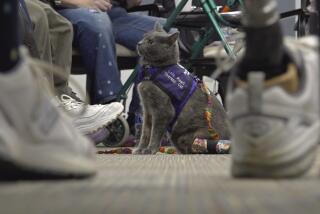Cheetah cub: Headless running robot cat could aid in rescue research
Here’s a cat that will do more whirring than purring: a robotic cheetah cub designed to trot at the fastest clip of any legged machine in its class. The mechanical running feline, described in the International Journal of Robotics Research, could help blaze a trail for engineers designing fast and agile rescue robots.
The headless, four-legged robot is about the size of a house cat, and its legs were designed with a typical kitty in mind, said lead author Alexander Sprowitz, a biomechanical roboticist at the Swiss Federal Institute of Technology in Lausanne. The 2.2-pound, roughly 8-inch robot has legs made of three segments proportioned similarly to a cat’s, where the top and bottom segments are positioned roughly parallel. The tendons are made of springs and the muscles are made of small motors called actuators.
The researchers chose to look at a cat because it’s a reasonable size – you’d have to make a much bigger treadmill to test an adult robotic tiger, for one thing – and yet it provides insight into the movement of just about any feline, Sprowitz said.
The robot can run up to 1.4 meters per second -- almost seven times the length of its body, but still just a fraction of the speed a typical housecat can achieve.
“We’re very crudely trying to mimic animals … [with] very crude material,” Sprowitz said.
Still, it’s blazing fast by small-robot standards, Sprowitz said. The cheetah can even go down stairs that are a fifth of its leg length – though going up stairs may be an entirely different challenge.
Despite its speed, the robot is remarkably stable, Sprowitz said, even without taking cues from the environment.
This research follows on other robots made by the Insitute’s Biorobotics Laboratory, including a salamander and a lamprey. The robotic cat will allow researchers to fiddle with the design and learn more about biomechanics without harming any real cats, Sprowitz said.
The scientists say that such research will help engineers design rescue robots that can navigate treacherous terrain – say, stairs in a house fire, or the rubble of an earthquake-struck building – that would quickly force a wheeled robot to a halt.
Follow me on Twitter @aminawrite.







